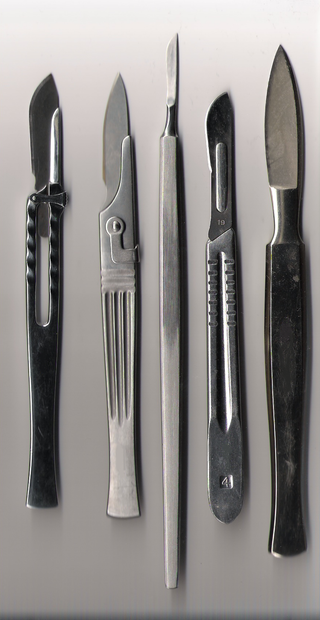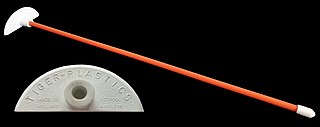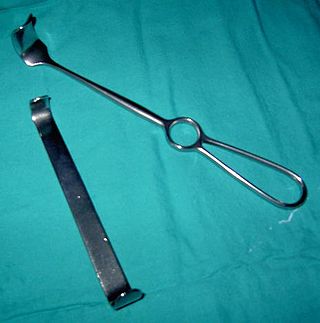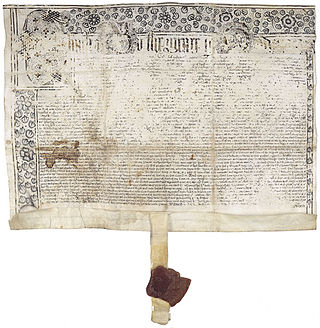
Laparoscopy is an operation performed in the abdomen or pelvis using small incisions with the aid of a camera. The laparoscope aids diagnosis or therapeutic interventions with a few small cuts in the abdomen.

A caltrop is an area denial weapon made up of two or more sharp nails or spines arranged in such a manner that one of them always points upward from a stable base. Historically, caltrops were part of defences that served to slow the advance of troops, especially horses, chariots, and war elephants, and were particularly effective against the soft feet of camels. In modern times, caltrops are effective when used against wheeled vehicles with pneumatic tires.

The Colony of Virginia was an English, later British, colonial settlement in North America between 1606 and 1776.

The House of Burgesses was the elected representative element of the Virginia General Assembly, the legislative body of the Colony of Virginia.

A spork is a form of cutlery and combination utensil taking the form of a spoon-like scoop with two to four fork-like tines. Spork-like utensils, such as the terrapin fork or ice cream fork, have been manufactured since the late 19th century; patents for spork-like designs date back to at least 1874. Sporks are commonly used by fast food restaurants, schools, prisons, militaries, backpackers, and airlines.

Slavery in the colonial history of the United States refers to the institution of slavery as it existed in the European colonies which eventually became part of the United States. Slavery developed due to a combination of factors, primarily the labour demands for establishing and maintaining European colonies, which had resulted in the Atlantic slave trade. Slavery existed in every European colony in the Americas during the early modern period, and both Africans and indigenous peoples were victims of enslavement by European colonizers during the era.

A spirit level, bubble level, or simply a level, is an instrument designed to indicate whether a surface is horizontal (level) or vertical (plumb). Two basic designs exist: tubular and bull's eye . Different types of spirit levels may be used by carpenters, stonemasons, bricklayers, other building trades workers, surveyors, millwrights and other metalworkers, and in some photographic or videographic work.

An endoscope is an inspection instrument composed of image sensor, optical lens, light source and mechanical device, which is used to look deep into the body by way of openings such as the mouth or anus. A typical endoscope applies several modern technologies including optics, ergonomics, precision mechanics, electronics, and software engineering. With an endoscope, it is possible to observe lesions that cannot be detected by X-ray, making it useful in medical diagnosis. Endoscopes use tubes which are only a few millimeters thick to transfer illumination in one direction and high-resolution images in real time in the other direction, resulting in minimally invasive surgeries. It is used to examine the internal organs like the throat or esophagus. Specialized instruments are named after their target organ. Examples include the cystoscope (bladder), nephroscope (kidney), bronchoscope (bronchus), arthroscope (joints) and colonoscope (colon), and laparoscope. They can be used to examine visually and diagnose, or assist in surgery such as an arthroscopy.

A surgical instrument is a medical device for performing specific actions or carrying out desired effects during a surgery or operation, such as modifying biological tissue, or to provide access for viewing it. Over time, many different kinds of surgical instruments and tools have been invented. Some surgical instruments are designed for general use in all sorts of surgeries, while others are designed for only certain specialties or specific procedures.

Belting is the use of belts made of strong materials as a whip-like instrument for corporal punishment. Although also used in educational institutions as a disciplinary measure, it has most often been applied domestically by parents. This practice has now been abolished by most schools, at least in the Western world, as it is seen by many as an abusive and excessive punishment.

The bottle scraper is a Dutch kitchen tool similar to a small spatula. It is designed to scrape the contents of long bottles that would be impossible to reach with other kitchen tools. Although the tool is sold in Norway and has even been described in some accounts as having originated there, it was introduced in the Netherlands around 1954 by a Dutch family-owned company Tijger Plastics NV founded in 1950 and nowadays operating as Coram NV. The bottle scraper was patented on 31 March 1967 and it is cited as a quintessentially Dutch tool as well as an example of Dutch thrift.
The spurtle is a wooden Scottish kitchen tool, dating from the 15th century, that is used to stir porridge, soups, stews, and broths.

A retractor is a surgical instrument used to separate the edges of a surgical incision/wound or to hold away certain organs and tissues so that body parts underneath may be accessed during surgical operations.

Sir Francis Wyatt (1588–1644) was an English nobleman, knight, politician, and government official. He was the first English royal governor of Virginia. He sailed for America on 1 August 1621 on board the George. He became governor shortly after his arrival in October, taking with him the first written constitution for an English colony. Also sailing with him on this voyage was his second cousin Henry Fleete Sr., who helped found colonies in both Virginia and Maryland. In 1622 he rallied the defence of Jamestown which was attacked by Native Americans, during which the lives of some 400 settlers were lost and he then oversaw the contraction of the colony from scattered outposts into a defensive core.

Dental instruments are tools that dental professionals use to provide dental treatment. They include tools to examine, manipulate, treat, restore, and remove teeth and surrounding oral structures.

A kitchen scraper is a kitchen implement made of metal, plastics, wood, rubber or silicone rubber. In practice, one type of scraper is often interchanged with another or with a spatula for some of the various uses.
Computer-assisted surgery (CAS) represents a surgical concept and set of methods, that use computer technology for surgical planning, and for guiding or performing surgical interventions. CAS is also known as computer-aided surgery, computer-assisted intervention, image-guided surgery, digital surgery and surgical navigation, but these are terms that are more or less synonymous with CAS. CAS has been a leading factor in the development of robotic surgery.
Single-port laparoscopy (SPL) is a recently developed technique in laparoscopic surgery. It is a minimally invasive surgical procedure in which the surgeon operates almost exclusively through a single entry point, typically the patient's navel. Unlike a traditional multi-port laparoscopic approach, SPL leaves only a single small scar.
A retained surgical instrument is any item inadvertently left behind in a patient’s body in the course of surgery. There are few books about it and it is thought to be underreported. As a preventable medical error, it occurs more frequently than "wrong site" surgery. The consequences of retained surgical tools include injury, repeated surgery, excess monetary cost, loss of hospital credibility and in some cases the death of the patient.

During a 104-year period from 1626 to 1730, there are documented Virginia Witch Trials, hearings and prosecutions of people accused of witchcraft in Colonial Virginia. More than two dozen people are documented having been accused, including two men. Virginia was the first colony to have a formal accusation of witchcraft in 1626, and the first formal witch trial in 1641.















